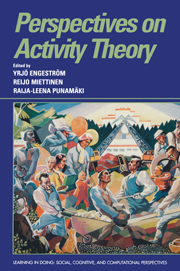Book contents
- Frontmatter
- Contents
- List of contributors
- Series foreword
- Introduction
- Part I Theoretical issues
- Part II Language and its acquisition
- Part III Play, learning, and instruction
- 14 Play and motivation
- 15 Drama games with 6-year-old children: Possibilities and limitations
- 16 Activity formation as an alternative strategy of instruction
- 17 Activity theory and history teaching
- 18 Didactic models and the problem of intertextuality and polyphony
- 19 Metaphor and learning activity
- 20 Transcending traditional school learning: Teachers' work and networks of learning
- Part IV Technology and work
- Part V Therapy and addiction
- Author index
- Subject index
15 - Drama games with 6-year-old children: Possibilities and limitations
Published online by Cambridge University Press: 05 June 2012
- Frontmatter
- Contents
- List of contributors
- Series foreword
- Introduction
- Part I Theoretical issues
- Part II Language and its acquisition
- Part III Play, learning, and instruction
- 14 Play and motivation
- 15 Drama games with 6-year-old children: Possibilities and limitations
- 16 Activity formation as an alternative strategy of instruction
- 17 Activity theory and history teaching
- 18 Didactic models and the problem of intertextuality and polyphony
- 19 Metaphor and learning activity
- 20 Transcending traditional school learning: Teachers' work and networks of learning
- Part IV Technology and work
- Part V Therapy and addiction
- Author index
- Subject index
Summary
Introduction
The cultural-historical understanding of play activity (Vygotsky, 1978; El'konin, 1980; Leont'ev, 1981) has had a growing impact on professional educators during the last decade. Play may be regarded as a subjective reflection of reality. In play the child reproduces observations and experiences in his or her own way. Play is a creative activity. Through play, the child changes his or her surroundings, leaving out something and inventing something. Fiction, imagination, and fantasy are essential. The child works out actions of make-believe and gives new meanings to actions and objects.
Play is voluntary and independent. If you try to force play, children will stop playing. Play is a social activity in which human relations are essential and are expressed together with peers. The motive of play is in the process itself, in the contents of the action, not in the result. The motive of play is unconscious, but the goal is conscious. “Nor does the presence of such generalized emotions in play mean that the child herself understands the motives giving rise to the game” (Vygotsky, 1978, p. 93).
Important changes take place in the preschool child's psyche through play. They pave the way for the child's transition to a new level of development (Leont'ev, 1981, p. 369). The leading function and impact of play activity have a number of causes. In the first place, all three mediating factors, that is, tools, signs, and other people (Vygotsky, 1978, pp. 54–57; Leont'ev, 1978, p. 59), are active in the child's play activity.
- Type
- Chapter
- Information
- Perspectives on Activity Theory , pp. 250 - 263Publisher: Cambridge University PressPrint publication year: 1999
- 10
- Cited by



